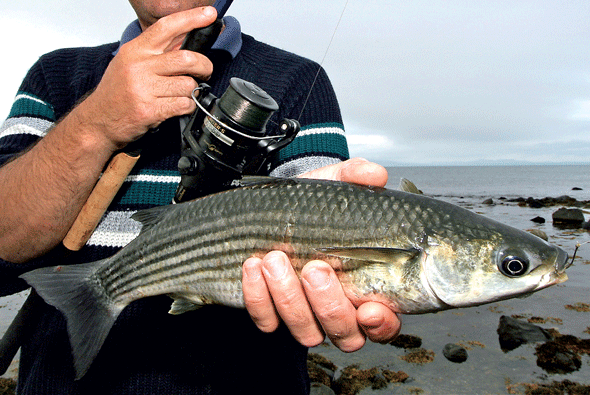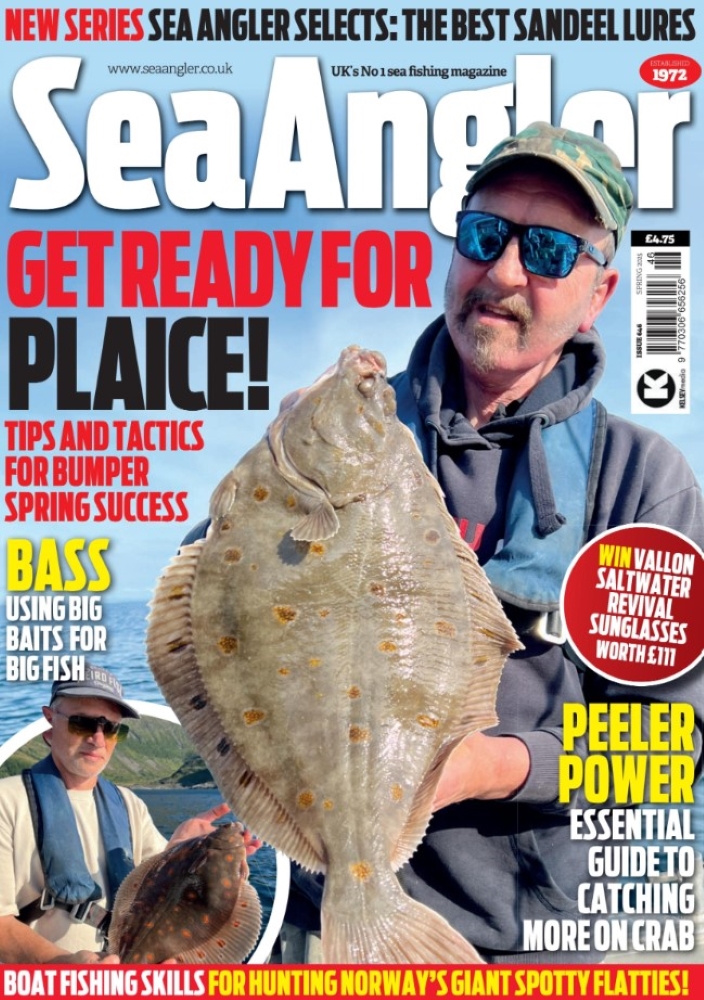The biggest mullet Steve Walker has seen, about 12lb, was at the Isle of Whithorn in south-west Scotland, and he called it Herman the Monster. The pursuit of a double-figure mullet is now his obsession…
Late August, early September, and some years, even into October, always see some large mullet being caught from the Isle of Whithorn area of Dumfries and Galloway.
There are two types of mullet fishing here. Firstly the more sedentary session when fishing from the rock edges. This is when I will groundbait two or three marks close together so that I don’t have to move around too much, and, as long as there are some mullet visible, I am happy to stay at one mark for a day.
The other method is when the mullet are feeding close in on the shallow beaches. Then I need to move around, sometimes walking several miles. Nowadays it is the norm to find one or two smaller groups of fish spread out along a beach, so it is necessary to do a lot of walking to find them. Before I start fishing I set up one rod to float fish and the other for freelining or dappling, but it can also be used to fish floating crust.
At my rock mark, one groundbait bag goes over the side away from where I am starting to fish. It is tied via a thin cord to a metal pin that I hammered into a fissure in the rocks years ago. I suspend it about two feet under the water, and adjust the depth as the tide floods or ebbs.
Nearby, there is a big gully with ledges, so if the tide is flooding I can put groundbait along the ledges.
Perched high up above the water, I can usually see anything swimming about in the right conditions. I groundbait by hand, usually throwing out a few spoonfuls every 15 minutes. Therefore, on a flooding tide I can have three different locations to fish from. Catch a fish and scare off any others and I can move, or if there is nothing showing after an hour at one location I can move and come back later.
PLAY THE WAITING GAME
One beach mark session I remember was a late-evening stint. It was windy on the open shoreline where most of the better rock marks are, but here it was sheltered and the wind was behind me and I could get a reasonable cast out if necessary. If I needed to fish a floating crust at long range, I could use the cork method and let the wind take the bait out.
I’d only a few hours before it got dark, so at least I didn’t need a big bucket of groundbait. A few loaves crumbed up and mixed with sea water sufficed. Good quality fresh bread is essential; it has to be moist enough to give it a bit of toughness, but light enough to float on the surface.
I prefer bread buns for bait because the underside where it has been baked on the tray is often tough, and a bit of force can be used to cast it out. Once in the water the bread part quickly softens and expands but still retains air pockets to float.
When mullet are feeding warily the hardest thing to do is not to strike on the first nudge of the bait. Wait and the fish might take it next time, often within seconds.
I fished in only a few inches of water so a floating crust was the only way to get any confident bites. If the fish are beyond casting range, then a wine cork can be attached to the line and allowed to drift out with bread in tow if the wind direction is favourable. If the fish are feeding just sub-surface then a moist piece of bread can be squeezed gently onto the hook, so that it becomes neutrally buoyant and bobs beneath the surface.
The only problem is watching the bait, especially in bright sunshine. You have to stand up, so camouflage clothing is a good idea, fluorocarbon line is essential, and rubbing a floating agent on the hook length and first 20 metres of mainline can help to stop the line from sinking.
Walking along the shoreline, I spotted a mullet in the shallows and more were showing between the rocks and waiting for the tide to flood onto the top of the beach.
I set up to fish a basic legered floating crust rig. Keeping back from the edge I made sure that the rod tip didn’t point up in the air because mullet can see this. I crouched down, made my way to the edge of the flooding tide and threw out some groundbait. I spread out a bit of ground bait along the ground above the tide, so that when it flooded there was something there to keep the mullet interested.

Throw groundbait on the rocks and the tide floods
Occasionally, the splash of groundbait on the surface attracts the fish to that spot, and the same thing happens when casting out a hookbait. They will take it so quickly that I don’t have time to turn over the bale-arm and get into the striking position.
I cast out and straight away a mullet hit the bait without hooking itself. After baiting up again the same thing happened, I just wasn’t quick enough. Next time, I cast over to the left into an area free of any weed, away from the previous two takes. I tightened up the line ready to strike and could see a mullet swim towards the bread.
The fish took it, so I struck and the water erupted into a splashing, head-shaking frenzy. I stood up to play the fish and slackened off the drag before the mullet made a run out to sea. I didn’t try to stop it.
I had to stand on top of a boulder and hold the rod high in the air to avoid any weed. The fish slowed down about 40 metres out, so I put three clicks on the drag, managed to hold the fish for a few seconds and let it run again. This time it went along the beach and away from the other fish.
I managed to walk down the beach while trying stop the fish from getting into some heavy weed. After 10 minutes I guided it towards the shallows, set to nil just in case of a last-ditch escape attempt and controlled the line tension by keeping one finger pressed on the spool. The mullet, around 3lb 4oz, went straight into the waiting landing net. It was unhooked and released.
ONLY ONE THING FOR IT
Surprisingly, there were still a lot of mullet present. Some more groundbait kept the fish feeding and I sneaked to within casting range and cast out. It took a few minutes to get a take and I missed it. Several casts later I resisted the urge to strike when a fish swirled around the floating bread and, thankfully, the bread was still there. Another swirl told me the fish was still interested.
I saw the mullet take the bread and I struck into a nice fish. It took off immediately, but I was quick enough to slacken the drag. It went straight for the weed, snagged me up and still took line, but I couldn’t get any back. Everything went solid, but the rod tip nodded a few times so the fish was still on.
There was only one thing for it – off with my boots and trousers and I waded out onto a big rock in an attempt to free the line. I untangled the line, freed it from the main snag, then climbed on top of the rock, tightened the line and the fish was still on.
Problem now was that the landing net was way behind me, but I could play the fish freely because the others had gone. Eventually it tired and I had to take a chance and put a bit of pressure on to guide it to the shore, where I beached it. It had felt a lot bigger, but was around 3lb.
Not a bad result. Luckily I had the fish feeding from the start, and two fish around the 3lb mark is slightly below average, but welcome nonetheless. The next day I lost two bigger fish, but finished the week with seven mullet, biggest around 5lb.

WHAT’S THE CORK METHOD?
This is a freelined rig with a split wine cork attached to the mainline, like a split shot is attached. The mainline is tied to a small swivel, and a 5ft length of 4lb fluorocarbon hook line is tied to the remaining eye of the swivel. The cork butts up against the swivel, is held in place by a stop knot, and acts as a weight. I used to use Drennan Sub Surface Green fly leader line for hooklengths, but now I always use fluorocarbon because it is essentially invisible.
WHAT IS DAPPLING?
It means suspending a bait at a rod’s length just sub-surface at a depth where any fish are feeding and waiting for a fish take the bait.







